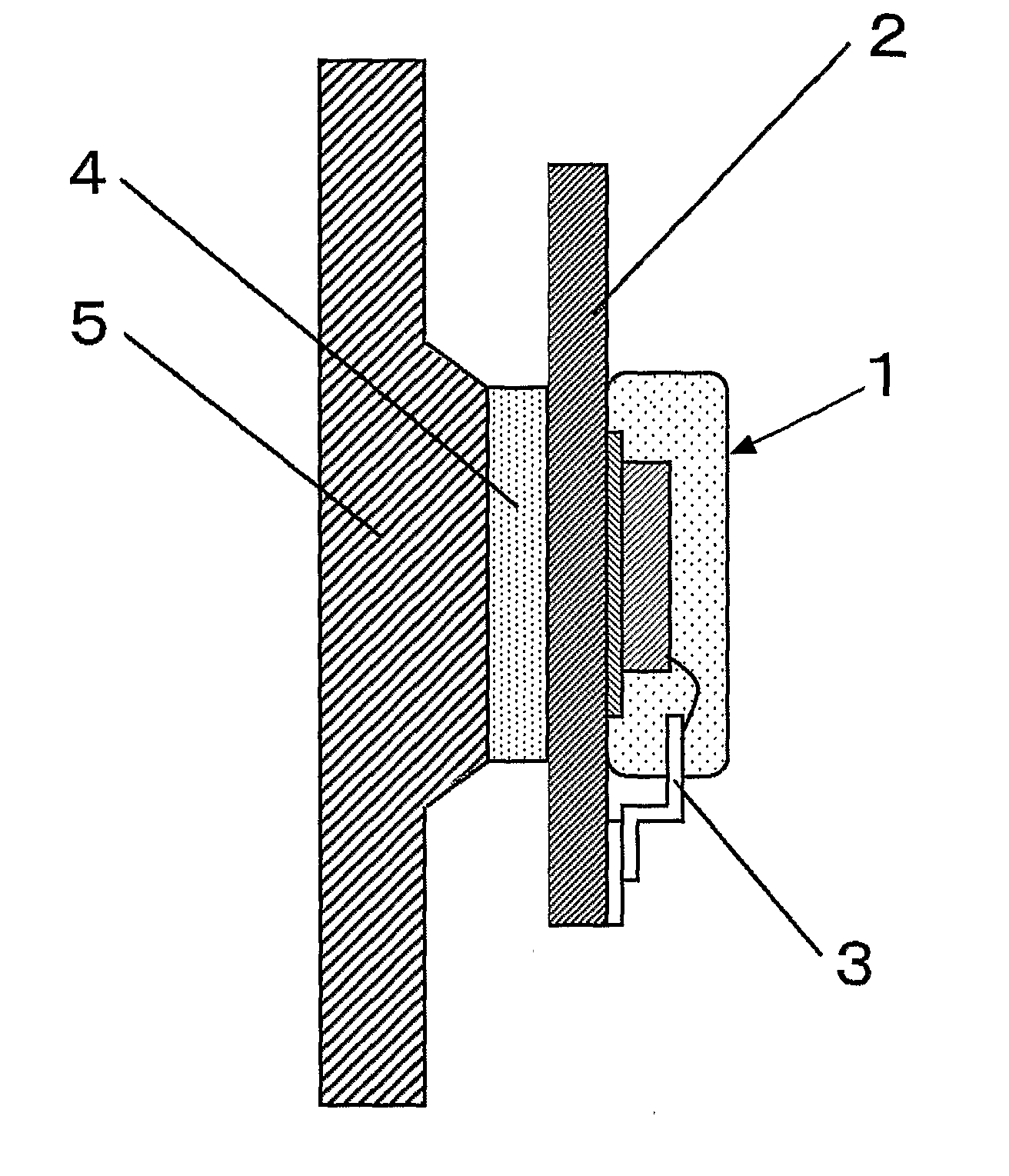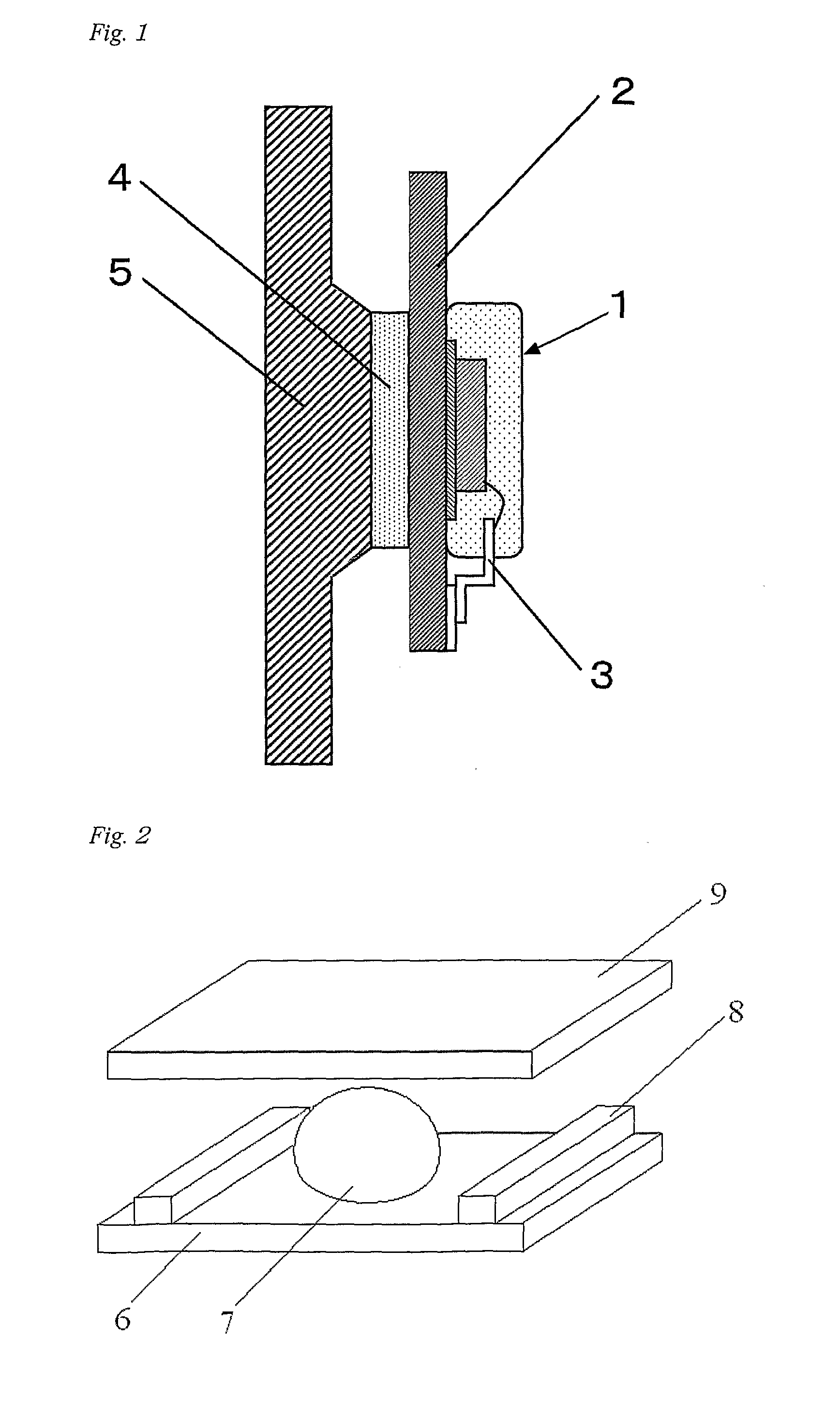Thermally conductive silicone composition and electronic device
a technology of silicone composition and electronic device, which is applied in the direction of electrical apparatus and process, electrical circuit non-printed electric component association, electrical apparatus contruction details, etc., can solve the problem of coating beginning to slip off, and achieve excellent handleability and workability, and excellent reliability
- Summary
- Abstract
- Description
- Claims
- Application Information
AI Technical Summary
Benefits of technology
Problems solved by technology
Method used
Image
Examples
example 1
Practical Example 1
[0074]A mixture was obtained by mixing the following components at room temperature in a Ross mixer: 100 parts by mass of a dimethylpolysiloxane capped at both molecular terminals with dimethylvinylsiloxy groups (viscosity: 2,000 mPa·s); 26 parts by mass of a dimethylpolysiloxane (viscosity: 25 mPa·s) represented by the following formula:
and 4 parts by mass of fumed silica having a BET specific surface area of 200 m2 / g and hydrophobically surface-treated with hexamethyldisilazane. The mixture was then combined and further mixed with the following components: 200 parts by mass of a finely powdered zinc oxide having an average particle size of 0.12 μm; 500 parts by mass of finely crushed alumina powder having an average particles size of 1.2 μm; and 470 parts by mass of a finely powdered alumina having round particles with an average particle diameter of 20 μm. Following this, 13 parts by mass of methyl trimethoxysilane were added, the components were uniformly mixe...
example 2
Practical Example 2
[0075]A mixture was obtained by mixing the following components at room temperature in a Ross mixer: 100 parts by mass of a dimethylpolysiloxane capped at both molecular terminals with dimethylvinylsiloxy groups (viscosity: 2,000 mPa·s); 26 parts by mass of a dimethylpolysiloxane (viscosity: 125 mPa·s) represented by the following formula:
and 4 parts by mass of fumed silica having a BET specific surface area of 200 m2 / g and hydrophobically surface-treated with hexamethyldisilazane. The mixture was then combined and further mixed with the following components: 200 parts by mass of a finely powdered zinc oxide having an average particle size of 0.12 μm; 500 parts by mass of finely crushed alumina powder having an average particle size of 1.2 μm; and 470 parts by mass of a finely powdered alumina having round particles with an average particle diameter of 20 μm. Following this, 13 parts by mass of methyl trimethoxysilane were added, the components were uniformly mixe...
example 3
Practical Example 3
[0076]A mixture was obtained by mixing the following components at room temperature in a Ross mixer: 48 parts by mass of a dimethylpolysiloxane capped at both molecular terminals with dimethylvinylsiloxy groups (viscosity: 10,000 mPa·s); 52 parts by mass of a dimethylpolysiloxane capped at both molecular terminals with dimethylvinylsiloxy groups (viscosity: 2,000 mPa·s); 25 parts by mass of a dimethylpolysiloxane (viscosity: 25 mPa·s) represented by the following formula:
and 4 parts by mass of fumed silica having a BET specific surface area of 200 m2 / g and hydrophobically surface-treated with hexamethyldisilazane. The mixture was then combined and further mixed with the following components: 220 parts by mass of a finely powdered zinc oxide having an average particle size of 0.12 μm; 520 parts by mass of finely crushed alumina powder having an average particle size of 1.2 μm; and 360 parts by mass of a finely powdered alumina having round particles with an average...
PUM
| Property | Measurement | Unit |
|---|---|---|
| viscosity | aaaaa | aaaaa |
| viscosity | aaaaa | aaaaa |
| viscosity | aaaaa | aaaaa |
Abstract
Description
Claims
Application Information
 Login to View More
Login to View More - R&D
- Intellectual Property
- Life Sciences
- Materials
- Tech Scout
- Unparalleled Data Quality
- Higher Quality Content
- 60% Fewer Hallucinations
Browse by: Latest US Patents, China's latest patents, Technical Efficacy Thesaurus, Application Domain, Technology Topic, Popular Technical Reports.
© 2025 PatSnap. All rights reserved.Legal|Privacy policy|Modern Slavery Act Transparency Statement|Sitemap|About US| Contact US: help@patsnap.com



